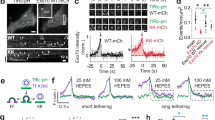Abstract.
The lipophilic fluorescent dye, FM1-43, as now frequently used to stain cell membranes and to monitor exo-endocytosis and membrane recycling, induces a cortical [Ca2+] i transient and exocytosis of dense core vesicles (``trichocysts'') in Paramecium cells, when applied at usual concentrations (≤10 μm) in presence of extracellular Ca2+ ([Ca2+] o = 50 μm). When [Ca2+] o is kept at 30 nm (<[Ca2+]rest i ), in about one third of the population of extrudable trichocysts docked at the cell membrane, FM1-43 induces membrane fusion, visible by FM1-43 fluorescence of the vesicle membrane. However, in this system extrusion of secretory contents cannot occur in absence of any sufficient Ca2+ o . Upon readdition of Ca2+ o or some other appropriate Me2+ o at 90 μm, secretory contents can be released (complete exocytosis). Resulting ghosts formed in presence of Ca2+, Sr2+ or Mn2+ are vesicular, but when formed in presence of Mg2+, for reasons to be elucidated, they are tubular, though both types are endocytosed and lose their FM1-43 stain. In contrast, in presence of [Mg2+] o = 3 mm (which inhibits contents release), the exocytotic openings reseal and intact trichocysts with labeled membranes and with still condensed contents are detached from the cell surface (``frustrated exocytosis'') within ∼15 min. They undergo cytoplasmic streaming and saltatory redocking, with a half-time of ∼35 min. During this time, the population of redocked trichocysts amenable to exocytosis upon a second stimulus increases with a half-time of ∼35 min. Therefore, acquirement of competence for exocytotic membrane fusion may occur with only a small delay after docking, and this maturation process may last only a short time. A similar number of trichocysts can be detached by merely increasing [Mg2+] o to 3 mm, or by application of the anti-calmodulin drug, R21547 (calmidazolium). Essentially we show (i) requirement of calmodulin and appropriate [Me2+] to maintain docking sites in a functional state, (ii) requirement of Ca2+ o or of some other Me2+ o to drive membrane resealing during exo-endocytosis, (iii) requirement of an ``empty'' signal to go to the regular endocytotic pathway (with fading fluorescence), and (iv) occurrence of a ``filled'' signal for trichocysts to undergo detachment and redocking (with fluorescence) after ``frustrated exocytosis''.
Similar content being viewed by others
Author information
Authors and Affiliations
Additional information
Received: 20 January 2000/Revised: 5 May 2000
Rights and permissions
About this article
Cite this article
Klauke, N., Plattner, H. ``Frustrated Exocytosis'' — A Novel Phenomenon: Membrane Fusion without Contents Release, Followed by Detachment and Reattachment of Dense Core Vesicles in Paramecium Cells. J. Membrane Biol. 176, 237–248 (2000). https://doi.org/10.1007/s00232001093
Issue Date:
DOI: https://doi.org/10.1007/s00232001093




